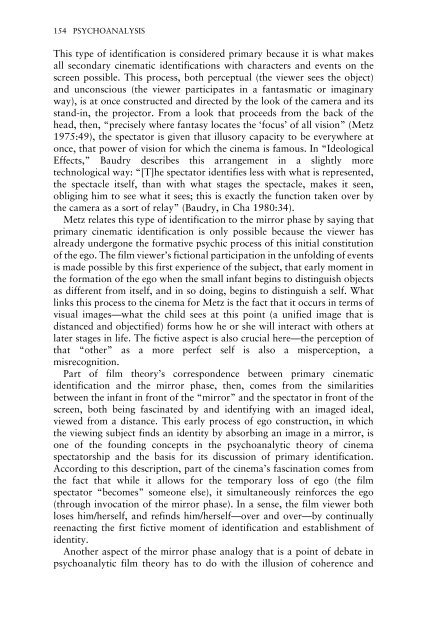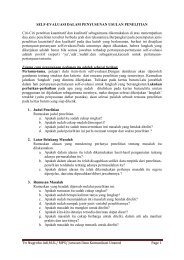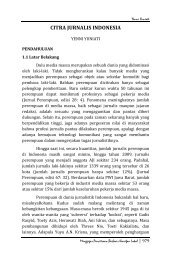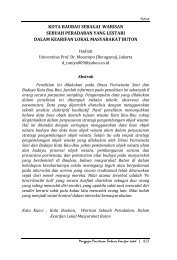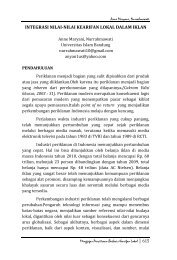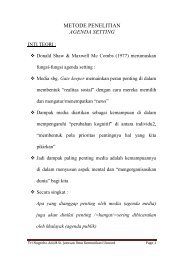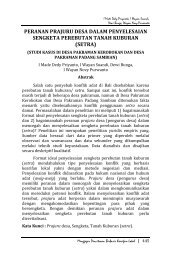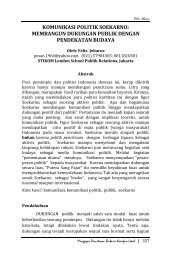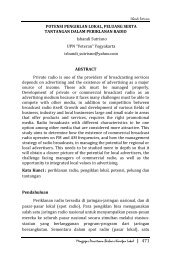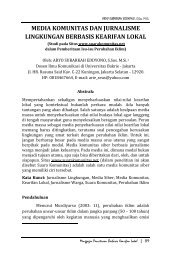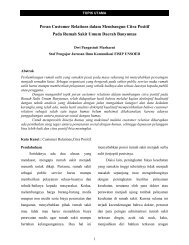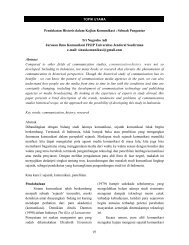New Vocabularies in Film Semiotics
New Vocabularies in Film Semiotics
New Vocabularies in Film Semiotics
Create successful ePaper yourself
Turn your PDF publications into a flip-book with our unique Google optimized e-Paper software.
154 PSYCHOANALYSIS<br />
This type of identification is considered primary because it is what makes<br />
all secondary c<strong>in</strong>ematic identifications with characters and events on the<br />
screen possible. This process, both perceptual (the viewer sees the object)<br />
and unconscious (the viewer participates <strong>in</strong> a fantasmatic or imag<strong>in</strong>ary<br />
way), is at once constructed and directed by the look of the camera and its<br />
stand-<strong>in</strong>, the projector. From a look that proceeds from the back of the<br />
head, then, “precisely where fantasy locates the ‘focus’ of all vision” (Metz<br />
1975:49), the spectator is given that illusory capacity to be everywhere at<br />
once, that power of vision for which the c<strong>in</strong>ema is famous. In “Ideological<br />
Effects,” Baudry describes this arrangement <strong>in</strong> a slightly more<br />
technological way: “[T]he spectator identifies less with what is represented,<br />
the spectacle itself, than with what stages the spectacle, makes it seen,<br />
oblig<strong>in</strong>g him to see what it sees; this is exactly the function taken over by<br />
the camera as a sort of relay” (Baudry, <strong>in</strong> Cha 1980:34).<br />
Metz relates this type of identification to the mirror phase by say<strong>in</strong>g that<br />
primary c<strong>in</strong>ematic identification is only possible because the viewer has<br />
already undergone the formative psychic process of this <strong>in</strong>itial constitution<br />
of the ego. The film viewer’s fictional participation <strong>in</strong> the unfold<strong>in</strong>g of events<br />
is made possible by this first experience of the subject, that early moment <strong>in</strong><br />
the formation of the ego when the small <strong>in</strong>fant beg<strong>in</strong>s to dist<strong>in</strong>guish objects<br />
as different from itself, and <strong>in</strong> so do<strong>in</strong>g, beg<strong>in</strong>s to dist<strong>in</strong>guish a self. What<br />
l<strong>in</strong>ks this process to the c<strong>in</strong>ema for Metz is the fact that it occurs <strong>in</strong> terms of<br />
visual images—what the child sees at this po<strong>in</strong>t (a unified image that is<br />
distanced and objectified) forms how he or she will <strong>in</strong>teract with others at<br />
later stages <strong>in</strong> life. The fictive aspect is also crucial here—the perception of<br />
that “other” as a more perfect self is also a misperception, a<br />
misrecognition.<br />
Part of film theory’s correspondence between primary c<strong>in</strong>ematic<br />
identification and the mirror phase, then, comes from the similarities<br />
between the <strong>in</strong>fant <strong>in</strong> front of the “mirror” and the spectator <strong>in</strong> front of the<br />
screen, both be<strong>in</strong>g fasc<strong>in</strong>ated by and identify<strong>in</strong>g with an imaged ideal,<br />
viewed from a distance. This early process of ego construction, <strong>in</strong> which<br />
the view<strong>in</strong>g subject f<strong>in</strong>ds an identity by absorb<strong>in</strong>g an image <strong>in</strong> a mirror, is<br />
one of the found<strong>in</strong>g concepts <strong>in</strong> the psychoanalytic theory of c<strong>in</strong>ema<br />
spectatorship and the basis for its discussion of primary identification.<br />
Accord<strong>in</strong>g to this description, part of the c<strong>in</strong>ema’s fasc<strong>in</strong>ation comes from<br />
the fact that while it allows for the temporary loss of ego (the film<br />
spectator “becomes” someone else), it simultaneously re<strong>in</strong>forces the ego<br />
(through <strong>in</strong>vocation of the mirror phase). In a sense, the film viewer both<br />
loses him/herself, and ref<strong>in</strong>ds him/herself—over and over—by cont<strong>in</strong>ually<br />
reenact<strong>in</strong>g the first fictive moment of identification and establishment of<br />
identity.<br />
Another aspect of the mirror phase analogy that is a po<strong>in</strong>t of debate <strong>in</strong><br />
psychoanalytic film theory has to do with the illusion of coherence and


